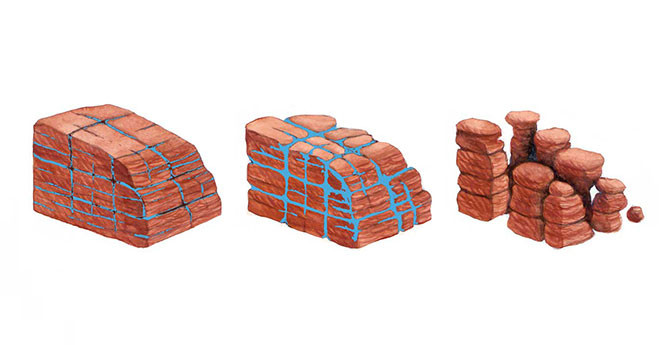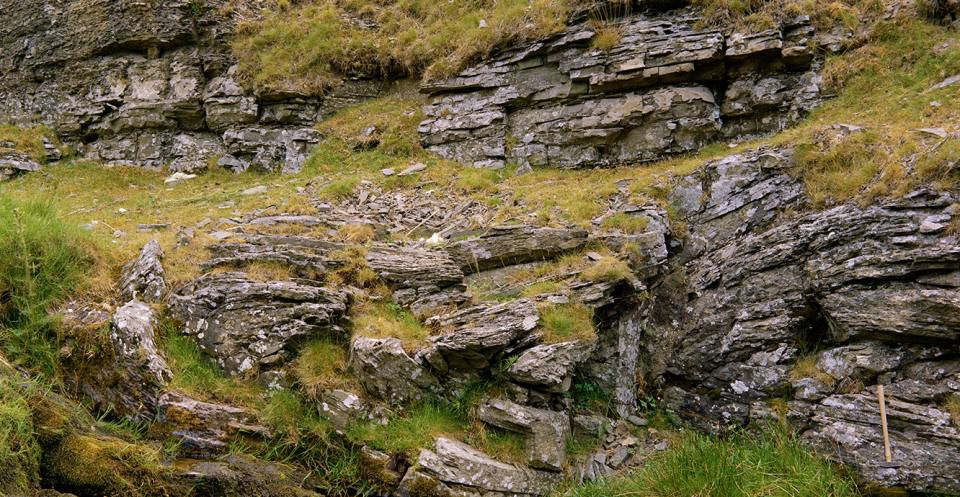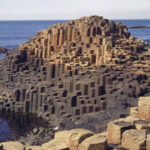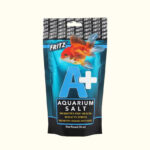How Rocks Are Weathered involves breaking down and altering them through various natural processes, and at rockscapes.net, we’re passionate about showcasing how these processes contribute to the unique beauty of natural stone used in landscaping. Understanding these weathering processes not only helps in selecting the right stone for your outdoor projects but also appreciates the artistry of nature. Let’s explore rock deterioration and degradation, as well as the impacts of erosion, for durable and aesthetically pleasing landscape designs.
1. What is Rock Weathering and Why Does It Matter?
Rock weathering is the breakdown of rocks into smaller pieces or altered substances at or near the Earth’s surface. This process is crucial because it shapes landscapes, creates soil, and influences water chemistry. For homeowners, landscape designers, and material suppliers, understanding weathering is essential for selecting durable materials and creating sustainable landscapes. At rockscapes.net, we emphasize choosing the right type of stone to withstand weathering, ensuring long-lasting beauty and structural integrity in your designs.
Weathering prepares the rock for erosion, which is the movement of the weathered material. Without weathering, erosion would be significantly slower. The products of weathering, such as soil and sediments, support plant life and ecosystems, while the chemical products can affect water quality, influencing aquatic life and human water sources.
2. What Are the Main Types of Rock Weathering?
There are three main types of rock weathering: physical, chemical, and biological. Each type contributes differently to the breakdown of rocks, and they often work together.
- Physical Weathering: This involves the mechanical breakdown of rocks into smaller pieces without changing their chemical composition.
- Chemical Weathering: This process alters the chemical composition of rocks, transforming them into new substances.
- Biological Weathering: This is caused by the actions of plants, animals, and microorganisms.
Understanding these types helps you appreciate the natural processes that shape the rocks we use in landscaping.
3. How Does Physical Weathering Break Down Rocks?
Physical weathering, also known as mechanical weathering, breaks down rocks through physical forces. Here are some key processes:
3.1. Freeze-Thaw Weathering
Freeze-thaw weathering occurs when water enters cracks in rocks, freezes, and expands. This expansion exerts pressure, widening the cracks. Repeated freezing and thawing cycles eventually cause the rock to break apart. This process is particularly effective in regions with frequent temperature fluctuations around freezing, such as the mountainous areas of Arizona.
 Freeze-thaw weathering breaking apart limestone in the Pennines of Yorkshire, UK.
Freeze-thaw weathering breaking apart limestone in the Pennines of Yorkshire, UK.
3.2. Exfoliation
Exfoliation, also known as unloading, happens when rocks formed deep underground are exposed at the surface. The reduction in pressure causes the rock to expand, resulting in the outer layers peeling off like the layers of an onion. This process is common in granite formations and can create unique rounded shapes in landscapes.
3.3. Abrasion
Abrasion involves the wearing down of rocks by the impact of other rocks and particles. Wind, water, and ice can carry these particles, grinding against rock surfaces. This process is particularly evident in riverbeds and coastal areas, where rocks are constantly bombarded by sediment.
3.4. Salt Weathering
Salt weathering occurs when salt solutions seep into porous rocks and evaporate, leaving salt crystals behind. As these crystals grow, they exert pressure, causing the rock to disintegrate. This is especially prevalent in arid and coastal environments where salt concentrations are high.
4. What Role Does Chemical Weathering Play in Rock Decomposition?
Chemical weathering alters the chemical composition of rocks through reactions with water, acids, and gases. Key processes include:
4.1. Hydrolysis
Hydrolysis is a chemical reaction where water reacts with minerals in the rock, forming new minerals. For example, feldspar, a common mineral in granite, can react with water to form clay minerals. This process weakens the rock structure, making it more susceptible to further weathering.
4.2. Oxidation
Oxidation occurs when oxygen reacts with minerals, particularly those containing iron. The most familiar example is the rusting of iron, where iron combines with oxygen to form iron oxide, which is weaker and more easily eroded. This process is evident in rocks that turn reddish or brownish over time.
4.3. Carbonation
Carbonation involves the reaction of rock minerals with carbonic acid, which is formed when carbon dioxide dissolves in water. This process is particularly effective on limestone and marble, which are composed of calcium carbonate. The carbonic acid dissolves the calcium carbonate, leading to the formation of caves and sinkholes.
4.4. Solution
Solution is the process where minerals dissolve directly in water. This is most effective on rocks containing soluble minerals like halite (rock salt). The minerals are carried away in solution, leaving behind pits and cavities in the rock.
5. How Do Plants and Animals Contribute to Biological Weathering?
Biological weathering is the breakdown of rocks by living organisms. Here are some key ways plants and animals contribute:
5.1. Root Wedging
Root wedging occurs when plant roots grow into cracks in rocks. As the roots grow larger, they exert pressure, widening the cracks and eventually splitting the rock. This process is common in forested areas and can be a significant factor in slope instability.
5.2. Burrowing Animals
Burrowing animals, such as earthworms, rabbits, and rodents, dig into rocks and soil, creating pathways for water and air to penetrate. This increases the surface area exposed to weathering, accelerating the breakdown of the rock. Additionally, their waste products can contribute to chemical weathering.
5.3. Lichens and Mosses
Lichens and mosses secrete acids that dissolve rock minerals. They also trap moisture against the rock surface, promoting chemical weathering. Over time, their growth can weaken the rock structure, making it more susceptible to physical weathering.
5.4. Microbial Activity
Microorganisms, such as bacteria and fungi, can break down rock minerals through various metabolic processes. Some microbes produce acids that dissolve rock, while others extract nutrients from the rock, weakening its structure. Microbial activity is particularly important in soil formation.
 Biological weathering at the headwater of the River Teme in Mid Wales.
Biological weathering at the headwater of the River Teme in Mid Wales.
6. What Environmental Factors Influence Weathering Rates?
Several environmental factors influence the rate at which rocks weather:
6.1. Climate
Climate is the most significant factor influencing weathering rates. Temperature and moisture levels play crucial roles. Warm, humid climates promote chemical weathering, while cold, wet climates favor freeze-thaw weathering. Arid climates can experience high rates of salt weathering.
6.2. Rock Type
Different rock types weather at different rates depending on their mineral composition and structure. For example, sedimentary rocks like sandstone and limestone are generally more susceptible to weathering than igneous rocks like granite and basalt.
6.3. Topography
Topography influences weathering rates by affecting water runoff and exposure to wind and sunlight. Steep slopes experience more erosion and physical weathering, while flat areas may accumulate water, promoting chemical weathering.
6.4. Pollution
Pollution, particularly acid rain, can significantly increase chemical weathering rates. Acid rain is formed when pollutants like sulfur dioxide and nitrogen oxides react with water in the atmosphere, creating sulfuric and nitric acids. These acids accelerate the dissolution of rock minerals.
7. How Does Weathering Contribute to Soil Formation?
Weathering is a fundamental process in soil formation. The breakdown of rocks provides the raw materials for soil, including mineral particles, organic matter, water, and air.
- Physical weathering reduces rock fragments to smaller sizes, increasing the surface area available for chemical reactions.
- Chemical weathering alters the mineral composition of the rock, releasing essential nutrients for plant growth.
- Biological weathering contributes organic matter to the soil and further breaks down rock particles.
Over time, these processes create a complex soil profile with distinct layers, each with its unique properties.
8. What Are Some Examples of Weathering in Landscape Design?
Understanding weathering is essential for selecting the right materials and designing landscapes that will stand the test of time. Here are some examples:
8.1. Stone Walls
Stone walls are a popular landscape feature, but different types of stone weather differently. Granite and basalt are highly durable and resistant to weathering, making them ideal for walls in harsh climates. Limestone and sandstone are more susceptible to weathering and may require periodic maintenance.
8.2. Paving Stones
Paving stones are subject to constant wear and tear from foot traffic and exposure to the elements. Choosing durable materials like slate or flagstone can ensure a long-lasting and attractive surface. Proper installation and drainage can also minimize weathering.
8.3. Water Features
Water features can accelerate weathering due to constant exposure to water and moisture. Selecting non-porous materials like granite or using sealants can help protect the stone from water damage.
8.4. Rock Gardens
Rock gardens showcase the beauty of natural stone, but it’s essential to consider how the rocks will weather over time. Choosing a variety of rock types with different weathering patterns can create an interesting and dynamic landscape.
9. What Are the Long-Term Effects of Weathering on Landscapes?
The long-term effects of weathering are profound and shape the landscapes we see around us. Weathering contributes to:
- Formation of valleys and canyons: Erosion, facilitated by weathering, carves out valleys and canyons over millions of years.
- Creation of beaches and coastlines: Weathering breaks down rocks along coastlines, creating sandy beaches and rocky shores.
- Development of soil profiles: Weathering is essential for the formation of fertile soils that support plant life and agriculture.
- Alteration of mountain ranges: Weathering gradually wears down mountain ranges, reducing their height and creating rounded peaks.
10. How Can I Protect Stone Features in My Landscape From Weathering?
Protecting stone features in your landscape from weathering involves several strategies:
10.1. Choose the Right Stone
Selecting durable, weather-resistant stone is the first step. Granite, basalt, and slate are excellent choices for their resistance to physical and chemical weathering.
10.2. Proper Installation
Proper installation can minimize water damage. Ensure good drainage to prevent water from pooling around stone features. Use appropriate mortar and sealants to protect against water penetration.
10.3. Regular Maintenance
Regular cleaning can remove dirt, debris, and organic matter that can accelerate weathering. Apply sealants and protective coatings to shield the stone from moisture and chemical attack.
10.4. Plant Strategically
Avoid planting vegetation too close to stone features, as roots can cause physical damage. Choose plants that do not secrete excessive acids that can harm the stone.
11. What Are Some Common Misconceptions About Rock Weathering?
There are several common misconceptions about rock weathering that can lead to misunderstandings and poor decisions:
11.1. Weathering Only Happens in Cold Climates
While freeze-thaw weathering is prominent in cold climates, weathering occurs in all climates. Warm, humid climates experience high rates of chemical weathering, while arid climates are prone to salt weathering.
11.2. All Rocks Weather at the Same Rate
Different rock types weather at different rates depending on their mineral composition and structure. Some rocks are naturally more resistant to weathering than others.
11.3. Weathering is Always Destructive
While weathering can break down rocks, it also plays a vital role in soil formation and nutrient cycling, which are essential for ecosystems.
11.4. Weathering is a Fast Process
Weathering is generally a slow process that occurs over long periods. However, certain factors, such as pollution and extreme weather events, can accelerate weathering rates.
12. How Does Climate Change Affect Rock Weathering?
Climate change is altering weathering patterns in several ways:
12.1. Increased Temperatures
Rising temperatures can accelerate chemical weathering rates, particularly in humid regions. Warmer temperatures also increase the frequency and intensity of extreme weather events, such as floods and droughts, which can exacerbate physical weathering.
12.2. Changing Precipitation Patterns
Changes in precipitation patterns can affect both physical and chemical weathering. Increased rainfall can promote chemical weathering and erosion, while prolonged droughts can lead to increased salt weathering.
12.3. Acid Rain
Increased levels of atmospheric pollutants can lead to more acid rain, accelerating the weathering of stone structures and monuments.
12.4. Sea Level Rise
Sea level rise can increase coastal erosion and salt weathering, threatening coastal landscapes and infrastructure.
13. What is Differential Weathering and Why Does It Occur?
Differential weathering is the process where different rock types weather at different rates, leading to uneven erosion and the formation of unique landforms. This occurs because:
13.1. Variation in Rock Composition
Different rocks have different mineral compositions and structures, making them more or less resistant to weathering. For example, a sandstone layer may weather more quickly than an adjacent layer of shale.
13.2. Differences in Exposure
Some rock surfaces may be more exposed to weathering agents like wind, water, and sunlight than others. This can lead to uneven weathering patterns.
13.3. Localized Environmental Conditions
Variations in moisture levels, temperature, and vegetation cover can create localized weathering patterns.
Differential weathering is responsible for many of the striking landscapes we see around the world, including mesas, buttes, and hoodoos.
14. What Advanced Technologies Are Used to Study Rock Weathering?
Scientists use a variety of advanced technologies to study rock weathering:
14.1. Remote Sensing
Remote sensing techniques, such as satellite imagery and LiDAR, can provide detailed information about rock surfaces and weathering patterns over large areas.
14.2. Geochemical Analysis
Geochemical analysis involves the study of the chemical composition of rocks and soils. This can help scientists understand the processes involved in chemical weathering and the movement of elements in the environment.
14.3. Microscopy
Microscopy techniques, such as scanning electron microscopy (SEM) and transmission electron microscopy (TEM), can provide high-resolution images of rock surfaces, revealing the microscopic features of weathering.
14.4. Geophysical Surveys
Geophysical surveys, such as ground-penetrating radar (GPR) and electrical resistivity tomography (ERT), can provide information about the subsurface structure of rocks and soils, helping to understand weathering processes at depth.
15. How Can I Identify Different Types of Weathering in My Backyard?
Identifying different types of weathering in your backyard can be a fun and educational activity. Here are some tips:
15.1. Look for Physical Weathering
Look for cracks in rocks that may be widened by freeze-thaw action. Check for rocks with rounded edges or smooth surfaces, which may be the result of abrasion.
15.2. Look for Chemical Weathering
Look for rocks with a reddish or brownish tint, which may indicate oxidation. Check for rocks that are crumbling or dissolving, which may be due to hydrolysis or solution.
15.3. Look for Biological Weathering
Look for plants growing in cracks in rocks, which may be contributing to root wedging. Check for lichens or mosses growing on rock surfaces.
15.4. Take Photos
Take photos of any interesting weathering features you find and compare them to examples online or in textbooks.
16. What Role Does Rock Type Play in Determining Weathering Susceptibility?
The type of rock is a critical factor in determining its susceptibility to weathering. Different rocks have varying mineral compositions, textures, and structures that influence how they respond to weathering processes.
16.1. Igneous Rocks
Igneous rocks, such as granite and basalt, are formed from the cooling and solidification of molten rock (magma or lava). They are generally more resistant to weathering due to their interlocking crystalline structure and relatively low porosity. However, they can still be susceptible to weathering through processes like exfoliation and hydrolysis.
16.2. Sedimentary Rocks
Sedimentary rocks, such as sandstone, limestone, and shale, are formed from the accumulation and cementation of sediments. They are generally less resistant to weathering than igneous rocks due to their higher porosity and permeability, as well as the presence of soluble minerals. For example, limestone is easily weathered by carbonation, while shale can be prone to physical weathering due to its layered structure.
16.3. Metamorphic Rocks
Metamorphic rocks, such as marble, quartzite, and slate, are formed when existing rocks are transformed by heat, pressure, or chemical reactions. Their resistance to weathering depends on the parent rock and the degree of metamorphism. For example, quartzite, formed from sandstone, is highly resistant to weathering, while marble, formed from limestone, is still susceptible to carbonation.
17. How Does the Porosity and Permeability of Rocks Affect Weathering?
Porosity and permeability are two important properties of rocks that significantly influence their weathering susceptibility.
17.1. Porosity
Porosity refers to the amount of open space within a rock. Rocks with high porosity, such as sandstone and pumice, can absorb more water, increasing their susceptibility to physical and chemical weathering. Water can enter the pores and exert pressure during freeze-thaw cycles or facilitate chemical reactions like hydrolysis and oxidation.
17.2. Permeability
Permeability refers to the ability of a rock to transmit fluids. Rocks with high permeability, such as fractured limestone, allow water to flow through them more easily, increasing the rate of chemical weathering. The flow of water can transport dissolved minerals and facilitate reactions throughout the rock mass.
18. How Can Vegetation Help Prevent or Reduce Rock Weathering?
Vegetation can play a significant role in preventing or reducing rock weathering through various mechanisms:
18.1. Soil Stabilization
Plant roots help stabilize soil and prevent erosion, reducing the exposure of underlying rocks to weathering agents.
18.2. Interception of Rainfall
Vegetation can intercept rainfall, reducing the amount of water that reaches the rock surface and minimizing the potential for chemical and physical weathering.
18.3. Shading
Vegetation can provide shade, reducing the temperature fluctuations on rock surfaces and minimizing the potential for thermal stress and exfoliation.
18.4. Chemical Buffering
Vegetation can absorb pollutants from the atmosphere, reducing the acidity of rainwater and minimizing the potential for chemical weathering.
18.5. Organic Matter
Decomposing organic matter from vegetation can create a protective layer on rock surfaces, reducing their exposure to weathering agents.
19. What Are the Ethical Considerations Related to Weathering and Landscape Design?
Ethical considerations related to weathering and landscape design involve balancing aesthetic preferences with environmental sustainability and long-term durability.
19.1. Material Selection
Choosing locally sourced, durable materials that are resistant to weathering can minimize environmental impact and ensure long-term sustainability.
19.2. Design for Durability
Designing landscapes that are resilient to weathering and erosion can reduce the need for maintenance and replacement, minimizing environmental impact and costs.
19.3. Preservation of Natural Features
Preserving natural rock outcrops and landforms can enhance the aesthetic value of landscapes while minimizing disturbance to natural processes.
19.4. Responsible Use of Resources
Using water and other resources responsibly can minimize the environmental impact of landscape maintenance and prevent the acceleration of weathering processes.
20. How Does Weathering Impact Historical Monuments and Buildings?
Weathering poses a significant threat to historical monuments and buildings, leading to their gradual deterioration and loss of cultural heritage.
20.1. Stone Degradation
Weathering can cause stone to crumble, crack, and dissolve, leading to the loss of architectural details and structural integrity.
20.2. Air Pollution
Air pollution, particularly acid rain, can accelerate the weathering of stone structures, leading to their rapid deterioration.
20.3. Climate Change
Climate change, with its increased temperatures and extreme weather events, is exacerbating the weathering of historical monuments and buildings, posing a significant challenge for their preservation.
20.4. Conservation Efforts
Conservation efforts involve a variety of strategies, including cleaning, repairing, and protecting stone surfaces, as well as controlling environmental factors like air pollution and moisture.
21. What are the differences between Weathering and Erosion?
While weathering and erosion are often discussed together, they are distinct processes:
- Weathering is the breakdown or decomposition of rocks in place. It weakens the rock, making it easier to be carried away.
- Erosion is the movement of the weathered material by agents such as water, wind, ice, and gravity.
Weathering prepares the rock for erosion. Without weathering, erosion would be significantly slower.
22. Frequently Asked Questions (FAQs) About How Rocks Are Weathered
22.1. What is the fastest type of rock weathering?
Chemical weathering, particularly in warm, humid climates, can be the fastest type due to the rapid chemical reactions.
22.2. Can human activities accelerate rock weathering?
Yes, pollution, deforestation, and construction can significantly accelerate weathering rates.
22.3. How does weathering affect the stability of slopes?
Weathering weakens rocks, making them more susceptible to landslides and slope failures.
22.4. What types of rocks are most resistant to weathering?
Igneous rocks like granite and basalt are generally more resistant due to their dense, interlocking crystalline structure.
22.5. How can I minimize weathering in my landscape?
Choose durable materials, ensure proper drainage, and maintain your landscape to prevent water pooling and vegetation damage.
22.6. What are the signs of chemical weathering on rocks?
Discoloration, crumbling, and the presence of rust-like stains can indicate chemical weathering.
22.7. Does weathering only occur on the Earth’s surface?
Yes, weathering primarily occurs at or near the Earth’s surface where rocks are exposed to the atmosphere, water, and biological activity.
22.8. What role do microorganisms play in weathering?
Microorganisms can break down rocks through metabolic processes, producing acids and extracting nutrients.
22.9. How does weathering contribute to the formation of caves?
Carbonation, a type of chemical weathering, dissolves limestone, leading to the formation of caves and sinkholes.
22.10. Why is understanding weathering important for landscape architects?
Understanding weathering helps landscape architects choose the right materials and design durable, sustainable landscapes that can withstand environmental conditions.
Understanding how rocks are weathered is crucial for anyone involved in landscape design, construction, or material supply. At rockscapes.net, we’re dedicated to providing you with the knowledge and resources you need to create stunning, long-lasting landscapes that celebrate the beauty of natural stone. Explore our website for more ideas, information on types of rocks, and expert advice on your next landscaping project. Contact us at 1151 S Forest Ave, Tempe, AZ 85281, United States or call +1 (480) 965-9011. Visit our website at rockscapes.net to discover the perfect stone for your landscape and learn how to protect it from the elements.

